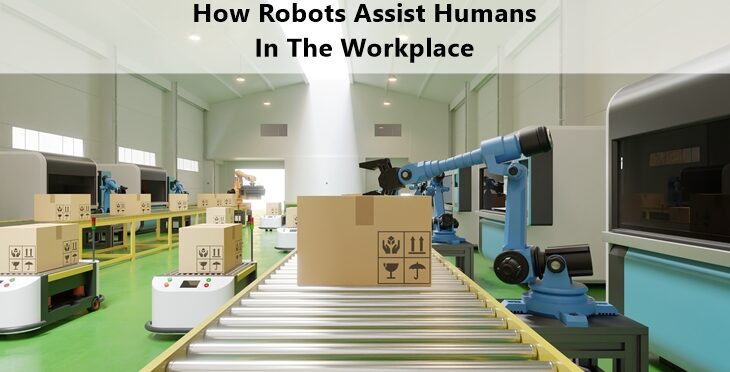Introduction
Robotics combines computer science, mechanical & electronics engineering, and science. It has enabled machine-related automation. These machines perform tasks previously performed by humans in a variety of settings. These include medicine, where robots perform surgeries previously performed by the surgeon's hand. Employers may now get work done faster and for less money, thanks to robots.
Robots are becoming more common in a variety of areas. Robots in manufacturing to health care have become very common. Many of the benefits of robots appear to be most obvious in terms of productivity, safety, and time and money savings.
How Robots Assist Humans In The Workplace
Robots Assisting Humans by Reducing the risk in Rescue Missions
Once inside a burning building, smoke and flames make it impossible for even the most experienced firemen to move. But, staff can put a new device called the SmokeBot into flaming structures. It tracks the progress of fires and the damage they inflict.
The SmokeBot differs from other firefighting robots. It develops inside maps that firefighters can use to navigate the structure later. It uses a mix of accessories, including a thermal camera and gas sensors, to create a map.
The US Navy also uses a firefighting robot to put out fires on ships. Arms on the piece of equipment can open doors or use hoses to aid in the fight and containment of the fire.
Robots do not eliminate the need for humans intervention. But, they can provide more information about what to expect. It then becomes easier to prepare or request additional assistance as needed.
Robots Assisting Humans in Cleaning Up Nuclear Sites
The nuclear energy sector is full of risks for people in it. It is constantly looking for new methods to expose robots to those risks.
Sellafield is an English nuclear power station. It specializes in nuclear fuel reprocessing and decommissioning. In the 1970s, a hotspot known as "D-Bay" began operating as a radioactive sludge dump. Sellafield has huge truckloads worth of sludge. It is a by-product of decaying nuclear fuel and other debris.
Officials at Sellafield and their partners were ready to start utilizing robots. These robots scooped up the toxic debris with arms attached to overhead cranes. This took a whole decade of planning. Another attachment for a crane can be a gadget that chops huge amounts of garbage into smaller parts. While maneuvering the robots, the operators remain sheltered behind a wall.
The Shadow Robot Company also offers a unique teleoperation device. It employs cutting-edge technology to help transform work in radioactive situations by allowing for remote handling. Their robotic arm enables users to handle things in a glove box from a distance without jeopardizing their safety. They can even control the robot's motions back at the cell by holding the hand in their shirt sleeves at a desk.
Robots are also assisting with the cleanup of the Fukushima Daiichi Nuclear Power Plant in Japan. It had gotten damaged by an earthquake and tsunami in 2011. A robot named The Sunfish assisted in the discovery of lost fuel inside a radioactive containment vessel. Many robots were unable to withstand the radiation. The Sunfish is assisting engineers in learning how to develop other robots to help with the aftermath.
Specialized Robots that Assist Humans in Decreasing Physical Work Dangers
Specialized Robots that Assist Humans in Decreasing Physical Work Dangers
One of the most dangerous works done manually is welding. During their shifts, welders must operate in intense temperatures and do exact duties. Robotic welding accounts for 29% of all welding applications, according to statistics. The most frequent method is spot welding, but arc welding is gaining ground.
Welding exposes people to harmful vapors. UV keratitis is a condition caused by UV light. Humans stay behind safety fences or interlocking doors when welding robots are in use. They are, however, required to inspect the robot's work. Humans need to guarantee that the equipment functions properly during the procedure.
Many individuals get concerned about robots taking their employment. But, this is an example of how robots could help us by making our jobs less dangerous than before.
Robots that Assist Humans in Rescuing Disaster Victims
Avalanches can be devastating when snowfall occurs. Researchers have been working on ways to use robots in rescue missions for years. These techniques have been improving over the years.
A project is underway at the University of Bologna to improve robot-assisted emergency help. Drones and radar locate persons in distress. The team behind this project believes that the results will save more lives. It would better equip rescuers to discover people faster than they would otherwise be able to.
Robots Assisting Humans in Pipeline Inspections
Pipeline inspectors are critical in preventing oil spills. This requires them to work in claustrophobic conditions and face additional hazards. However, even when pipeline inspections happen, they frequently fail to discover problems. In certain circumstances, they cannot accurately report issues. These flaws have prompted requests for changes in pipeline inspection equipment and technique.
Sending pressurized water through pipes to assess their strength or drilling into the earth to conduct spot tests were previously used to examine them. Diakont is one of the first companies to put robots into pipelines to inspect them a few years ago.
Ultrasonic sensors in the robots' two arms measure the perimeter of a pipeline and evaluate structural integrity. Diakont also created a robot for fuel storage tanks. It keeps operators out of the potentially explosive atmosphere created by flammable materials. This robot eliminates the need to drain the containers first. It thus saves up to two months of downtime while the gasoline gets removed.
Conclusion
While our article covers mostly industrial use, robots can be used in many other areas.
The Covid Pandemic is still at its peak. The most effective way to fight COVID is to reduce human exposure. It is a time of social distancing and robots can make it possible for businesses to keep running. This will also protect the customer and the employees.
We are still a long way from a robotic workplace. But the robotic capabilities that many firms are presently adopting have proven to be one of the most significant technological advances of our time. With further advances, robots will only make our lives easier.
You may like to read:
10 Best Practices for RPA Change Management





